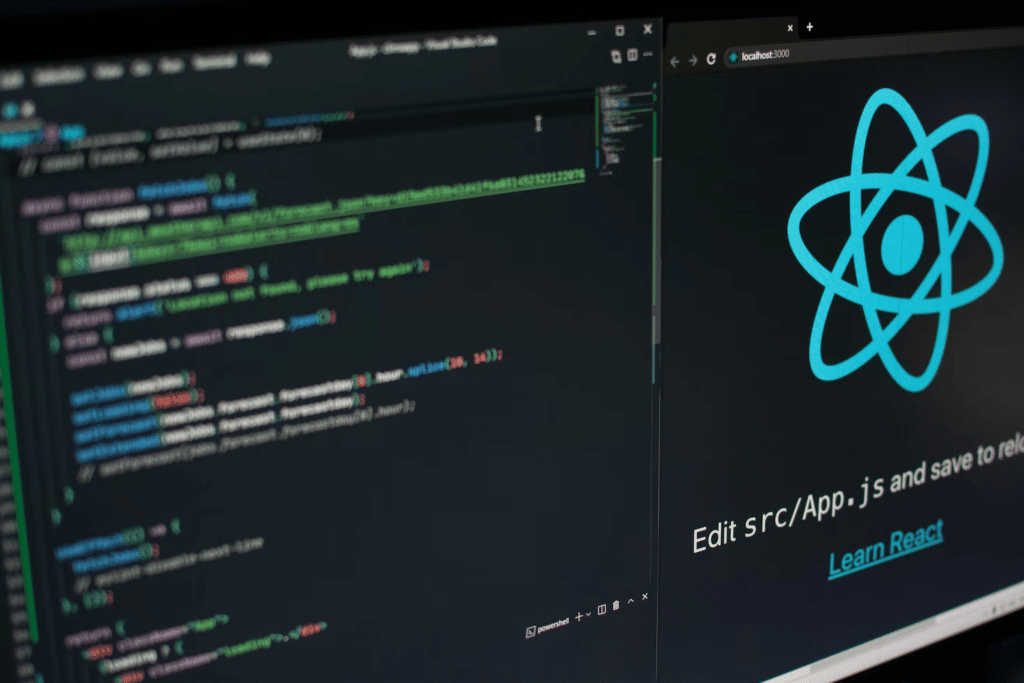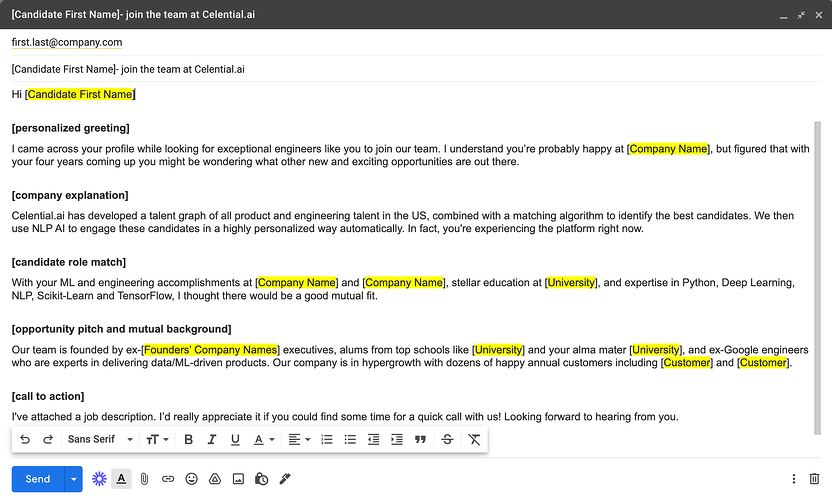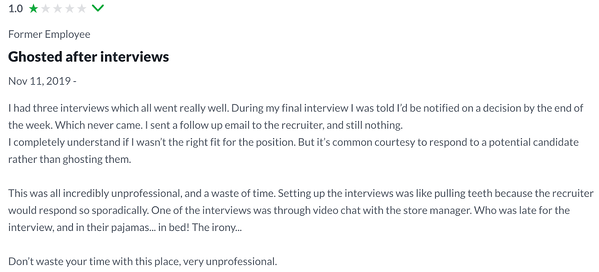Once again, full stack developers have topped the list of most sought-after software engineering roles in 2022 — and demand is so high that a recent Hay’s survey found that full stack developer salaries, already eye-wateringly large, rose another 17% in 2022.
To add insult to injury, there is a raging technical recruiter shortage. Many talent acquisition teams have to upskill their recruiting generalists in a short amount of time to know how to source for new technical roles.
Check out our complete walkthrough on how to hire a full stack developer below so you will be able to spot a full stack developer and effectively move them through the recruiting process to make a hire.
How to recognize a full stack developer or full stack engineer
Full stack developers are technical experts in coding “across the stack”: the user front end, API code in the middle, and server back end for web applications and software. With all of those skills, it’s no wonder that every tech company wants to hire a full stack developer!

We’ve put together three sample resumes for Full stack Developer, Senior Full stack Developer, and Principal Full stack Developer to illustrate what full stack development skills a recruiter should look for, typical full stack development projects and experiences, and how to gauge seniority.

Early-career Full Stack Developer
| Sample Resume: Amy Moore Hi! I’m Amy, a Computer Science grad from the University of California, Berkeley. I’m passionate about using technology and entrepreneurship to drive healthcare progress and innovation through full stack development. Professional Experience: Full Stack Developer at Novella Health (2021-) -On 4-person team designed and developed full stack interactive web application with front end in React and back end in Java to analyze and transform data -Core full stack development on a Java and AngularJS application to transmit very large files over a UDP protocol with reliability and security in mind. -Accelerated deployment of patches for security vulnerabilities Intern at Slack (Summer 2020) -Infrastructure team: Building tools to improve database performance Intern at IBM (Summer 2020) -Asset management tools and testing Education: UC Berkeley – BS in Computer Science and Electrical Engineering (2016-2020) UC Berkeley – MS in Computer Science (2021) Skills: JavaScript, HTML, CSS, Java, React, Angular, Node, MySQL, Python |
Resume breakdown:
You can identify early-career full stack developers by their combination of front end skills such as JavaScript, Angular, and React and back end skills and programming languages such as Python, Node, and Java. Full stack engineers may also reference their work on web applications, APIs, both the UI/UX, and the back end infrastructure.
Typically, strong early-career full stack engineers will have a “Software Engineer” or “Software Developer” job title. Other early-career titles include “Associate Software Developer”, “Software Development Engineer (SDE) I”, “Software Development Engineer (SDE) 2” and “Junior Developer” — though the last may indicate that a full stack web developer has not yet acquired significant software development experience.

Senior Full Stack Developer
| Resume: Robert Martin I am a full stack developer with an emphasis on modern JavaScript frameworks. Skilled in Node.js for developing back end and building RESTful API endpoints and React for building appealing and user-focused front end. Professional Experience: Senior Full Stack Developer at Toptal (2019-) – Responsible for full stack development and driving various initiatives focused on creating value for the organization through innovative technology solutions – Resolution of identified security vulnerabilities, conducting code reviews for team, streamlining and improving SDLC practices Senior Full Stack Developer at Trend Micro (2014-2019) – Responsible for full stack development with Node, JavaScript frameworks, and SQL databases – Designed and implemented UI as a single page application – Designed and implemented REST APIs Full Stack Developer at Datacloudz (2014-2014) – Full stack development for an early-stage startup – Work closely with customers to identify requirements and technical support. BS – Computer Science and Electrical Engineering at North Carolina State University (2012) Skills: JavaScript, Microsoft SQL Server, Node, React, CSS, Git, Java, Spring, Scala, Jenkins, Redis, Kubernetes, MongoDB, C#, SOAP, REST API |
Resume breakdown:
This full stack developer also has a solid mix of front end and back end experience. At the senior level, a recruiter would expect a full stack web developer candidates to demonstrate ownership of a feature or product from end to end, including design, planning, troubleshooting and implementation.

Senior full stack developers are also typically expected to participate in project management, interview processes and mentorships of junior developers.
Staff/Principal Full Stack Developer
| Resume: Elise Young Elise Young is a Staff Software Engineer with nine years of experience in Fullstack web application development. She received her BS in Computer Science from UC Santa Barbara. Professional Experience: Staff Engineer at Precisionly.ai (2020-present) Worked across teams, mentored new engineers, reviewed engineering designs Led frontend team in migrating the platform from Angular to React Implemented enterprise service architecture which can be split into microservices if needed Staff Engineer at Galvanize (Feb 2020 – Sep 2020) Responsible for the entire revenue optimization frontend. Maintain and improve on Java services Senior Engineer at Galvanize (2018-2020) Building the frontend app architecture as well as backend APIs 3rd party authentication integration, various visualization tools as well as app infrastructure Senior Frontend Engineer at Deloitte (2015-2019) UX design, frontend architect, core visualization, render optimization, componentizing elements, documentation, unit-test and backend data Software Engineer at Microsoft (2013-2015) Skills: Java, Python, Angular, React, JavaScript, APIs, Microservices, Docker, Kubernetes, Node, Express, Apache Spark, C, C++, C#.Net |
Resume breakdown:
At the Staff, Principal or Tech Lead level, full stack developers take ownership of increasingly complex problems and systems, with an impact on repeatable processes, overall engineering culture and the direction of the team.
Want to brush up on your technical terms for sourcing the best Full Stack developers and other in-demand software engineers? Check out our guide that covers everything you need to know for finding, evaluating, and contacting top developer talent.

How to conduct outreach
With only 3.4% of full stack engineers currently looking for a job, pursuing passive talent is vital to successfully filling an open full stack software developer position.
Persuading candidates to reply to your cold recruiting emails can feel almost impossible — let alone perennially in-demand full stack developers who are already happy at their current position.
However, we’ve found that it’s possible to boost your reply rate to 30% — even for those elusive full stack developers.
How do you do it?

By telling full stack developers a personalized story about why they should work with you.
Outreach tips:
- Explain how this opportunity fits into a full stack developer’s career trajectory and what your company can offer them in terms of culture, values, and personal growth
- Reference the full stack developer’s domain experience, technical skills, work history, and other background details. And don’t forget to personalize your subject line — this can lead to up to 50% better results.
- Mention common backgrounds such as education, career history, geographic location and mutual connections
- Send 2-3 follow ups to connect with many more full stack developers — according to our own company recruitment data, two thirds of replies come from follow ups.

Passive candidate cold outreach template: ultimate edition
To make it easy, here is a template we’ve put together that we’ve used to source and hire full stack developers. You can plug in your own company pitch and candidate background details to supercharge your reply rates.

After creating intrigue with a vague yet personalized subject line, this passive candidate email template keeps the focus on the candidate throughout the email – envisioning their state of mind and feelings about making a move, calling out their specific accomplishments, and establishing common background in the pitch.
Check out our blog post for more free passive candidate email templates to contact the best full stack developers.
Candidate experience for full stack developers
In the wake of the Great Resignation and ever-persistent tech talent shortage, candidate experience for full stack software developers is more important in landing a hire than ever.
“You should always treat your candidates like customers because your candidates are customers!” – Recruitment expert Jan Tegze
A few stats:
- 91% of HR professionals agree that candidate experience improves quality of hire
- Positive employer branding can save you $4,723 or more on cost per hire — and even more for costly roles like full stack software developers
- 42% of candidates who have a bad experience take their business elsewhere and may tell friends, family and social media as well
However, if candidates have a good recruitment experience, they are 80% more likely to apply again.
Tip #1: Good Communication
Full stack developers want a speedy and seamless recruitment process, as well as frequent and quick updates and scheduling.
Nothing makes a full stack developer unhappier than an employer who fails to communicate — in fact, it is the number one pain point for job seekers generally.

To avoid receiving a review like this, an ATS or automated system can help you keep track of full stack developer applicants who are awaiting feedback.
With three quarters of candidates reporting having been ghosted by employers, you’ll leave a positive lasting impression regardless of recruitment outcome.
Tip #2: Respect full stack developers’ time
As some of the most expensive, critical hires a company can make, full stack developers are asked to do it all — the front end, the back end, core product initiatives with tight deadlines, being pulled into product strategy meetings and called in for technical interviews.
It’s no wonder that full stack developers are some of the professionals at the highest risk for burnout.

You can make full stack developers happy and keep them engaged by streamlining the application, recruitment and scheduling process. And for busy recruiting teams, not having to track excessive stages and interview coordination will also lighten your load.
Start by noticing the bottlenecks in your recruiting process. For example, Flock Freight once had a take-home assignment requiring 4-8 hours to complete and it caused 50% of candidates to drop off. By replacing it with a 90-min on-site programming exercise, they reduced attrition to 20% and slashed time-to-hire in half.
Another practical tip is to ensure everyone in the hiring process has blocked off time on their calendar during an interview month to avoid scheduling or communication delays.
Tip #3: Make a personal connection
Another way to stand out from the horde of recruiters beating down a full stack developer’s door is to make a personal connection.

By beginning the interview with five or ten minutes of personal conversation, you’ll give your candidate some time to let go of interview stress and be themselves. And by showing genuine interest in them as a person, you’ll signal that they won’t be treated like a cog at your company.
Introducing small, personalized gestures into your recruitment process will really create a lasting impression. Here are some ideas:
- Remember details about them for post-interview correspondence
- Create a custom slide deck with their picture, preferred name, and other small details
- Send a small gift relevant to their interests after the interview
Tip #4: Transparency
Once you’ve designed your tight and streamlined recruiting process, it’s important to be transparent with full stack developer candidates about your timeline and next steps to keep them engaged.
A lack of clear expectations about the hiring process and long stretches of silence from employers will prompt full stack developers to explore their other options — the ones who are communicating with them.

It’s also crucial for recruiters to be transparent around salary, job responsibilities, and other key information in the beginning of the interview process — you’ll avoid wasting your time and candidates’ when there’s not a match.
Recruitment is an important window into your company’s culture — by being forthright, you’ll signal to full stack developers that you’ll treat them honestly and ethically as a workplace.
Tip #5: Branded Careers Page
Another great place to showcase your engineering team’s culture is a branded careers page. 75% of job seekers consider an employer’s brand before even applying for a job, and 65% consider the careers page.

With Millennial and Gen X workers who increasingly value culture over salary increasingly dominating the workforce, a strong careers page can help recruiters compete with even the biggest names in the battle for top full stack engineers.
Your careers page should showcase your company’s values, team culture, and intangible benefits such as a positive work environment, opportunities for personal growth, and inclusivity.
You may also consider having a dedicated engineering team page.
Some ideas to include:
- Shares information about your tech stack
- Software development challenges your team is tackling
- Opportunities for personal growth and development for full stack developers
- Team-building activities for remote full stack developers
- Hackathons
- Specific engineering benefits such as “no meeting” coding days
- Communities you are a part of and organizations you support
Full stack developer interview tips
Software developers agree that the technical interview is broken. But, there are ways to design interviews that full stack developers won’t hate! Let’s look at both the full stack developer skills assessment and effective questions for gauging culture fit.
How to optimize your full stack developer skills assessment portion

Here are a few tips for crafting an effective assessment of full stack development skills.
- Keep it short (1-2 hours maximum, or compensate developers for their time).
- Focus on concepts with an open-ended challenge rather than quizzing technical minutiae — most full stack web developers don’t bother to commit to memory what they can easily look up.
- Use a language-agonistic assessment. This will allow you to test a full stack developer’s fundamental technical knowledge, problem-solving ability and coding skill.
- Try out your assessment on your current team first to ensure that it’s a reasonable test of the skills a full stack developer will actually use on the job.

- Experiment with alternatives. One can be an assessment that is less of a “quiz” than a conversation — such as talking through a software development project they did on GitHub or a code sample they have provided in advance. Many of the best full stack developers don’t perform well under highly stressful and new situations.
- Administer the tests yourself rather than relying on automated grading if you use a coding challenge from a site such as Coderbyte or HackerRank. This way you won’t miss the nuance, elegance and creativity in your full stack developers’ solutions.
How to find a culture fit with full stack developers
Culture is notoriously difficult to screen for. It’s valuable to ask full stack developers about how they see themselves; however, a candidate’s self-perception may be quite different from reality.
Often, asking about how full stack web developers have actually handled situations and software development in the past gives you a better idea of how they operate and their individual strengths.
Culture fit assessment tips
- You might ask how a full stack developer has handled conflict or disagreement in the past.
- You might also ask a full stack developer to provide an example of a time they learned from a situation, or how they handled feedback.
- Even better, talking through a specific coding problem or hypothetical scenario can allow you to see how full stack developers think and problem-solve — also a good opportunity to offer some constructive feedback to see how they react.
Are they defensive, or open to other points of view?
To hire a full stack developer, it’s also valuable for recruiters get a good understanding of the culture and pace of a full stack developer’s current workplace. Though there are always exceptions, remote full stack developers at large enterprises such as Microsoft or Oracle might not be a good fit for an in-person founding engineer role at a small startup — and vice versa.

Sample Interview questions to assess full stack developers’ hard and soft skills
Consider asking these questions to identify and hire a full stack developer who will be a great fit for your team.
Question 1:
Walk me through one of the projects you’re most proud of — something that you saw from start to finish that you solely were a part of — from ideation to implementation. Who did you work with? What were the problems you were solving? What was your approach? How did you handle bottlenecks and setbacks in the development process? What did you learn — was there anything you could have done better, or did you pick up a new language, technology or skill?
Question 2:
What does your average workweek look like? How many code cycles do you typically go through in a month? How would you characterize your team’s processes?
Question 3:
What are the most important qualities a full stack developer must have? Would you characterize your full stack development background as leaning frontend or backend at all? What are the web development skills you hope to pick up in the future?
How startups can make a competitive offer to a full stack engineer
Here are some market salary data to help recruiters plan headcount and compensation targets for Full stack developer roles.

However, it’s important to note that pay may vary significantly depending on location and company, and that full stack developers who work full time are compensated differently from freelance full stack developers.
- A Full Stack Developer in the San Francisco Bay Area (CA) is compensated $132,221 annually on average but one in the Miami-Fort Lauderdale area (FL) makes $114,138.
- A Senior Full Stack Developer at a well-established tech company like Meta can receive up to $194,428 annually, while a Senior at a smaller company like Datadog would receive closer to $127,555.

Compensation based on seniority level
Not surprisingly, the average compensation for Junior to Principal level software engineers stays within the six figures in the United States based on data from Glassdoor:
- Junior Full Stack Developer or Engineer (0-1 years): $104,815 ($67,585 base; $37,230 additional)
- Software Full Stack Developer (0-3 years): $122,029 ($96,633 base; $25,396 additional)
- Senior Full Stack Developer (4-6 years): $134,981 ($117,711 base; $17,270 additional)
- Principal Full Stack Developer (7-9 years): $162,524 ($142,447 base; $20,078 additional)
Though startups can’t always compete on the total annual compensation number for salary, according to a recent study, Millennial tech professionals actually care more about benefits such as flexible work. Since Millennials will make up the bulk of the workforce by 2025, startups can get a leg up on the competition by including these benefits in their compensation.

In-demand benefits for full stack developers in 2023:
- Remote and Flexible work
- Health, Disability, and Life Insurance
- Team-building activities
- PTO – this is particularly important to avoid developer burnout
- Unique benefits and perks you won’t find anywhere else
- Generous stock options-At a company’s earliest stages, many founders expect to give a senior engineer as much as 1% of a company
For example, X-team offers an annual budget of $2,500 for things that energize you such as a gym membership or organic produce and runs regular X-Outposts, company retreats which take place for 2-3 weeks somewhere exotic in the world.
In order to show off your benefits in the best possible light and increase the odds of closing your full stack developer talent, we suggest that you present an offer in a personalized slide deck which clearly lays out your benefits, offers multiple options for equity and salary splits, and explains what equity compensation will actually look like in multiple exit scenarios.
Wrapping up: How much should hiring a full stack developer cost?

The total cost for hiring a full stack developer can be around $30,000 or more in 2022.
It’s no secret that software engineering salaries are a huge part of any tech company’s budget, and any reduction an employer can get in hiring costs is a huge advantage.
This is especially important during cost-saving times when talent acquisition department budgets are thrown out the window and their teams are understaffed.
AI-based solutions can help companies slash time and cost by streamlining their recruitment processes, providing access to vast amounts of data and extensive talent networks, and hyper-personalizing candidate outreach and engagement at scale.

Celential.ai’s Virtual Recruiter service delivers high-quality and engaged talent with zero effort or learning curve on your part — freeing your talent acquisition team to build and nurture candidate relationships and make top quality hires.
We offer:
- 80%+ Present-to-interview Ratio. Hiring teams accept 80%+ of the candidates we submit for interviews, including for hard-to-fill technical roles such as full stack developers, frontend and backend developers, engineering managers, machine learning engineers, and other specialized developers
- 3-Day. Average Turnaround. You receive warm talent ready for interviews in 1-5 business days.
- 50% Cost Saving. Our ‘Virtual Recruiter’ helps clients save 50% recruiting costs on average compared to other hiring methods.
With concerns about an economic slowdown, record-setting inflation, and VCs slowing down investing, 2022’s hiring market involves a lot of uncertainty and lower recruiting budgets for tech companies.
Celential.ai offers you the flexibility to scale up and down your recruiting efforts instantaneously as your hiring needs shift.
Schedule a call to learn more!
Table of Contents

































